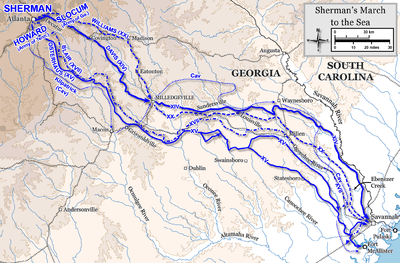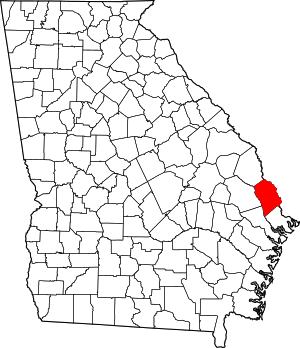Rincon, Georgia
Rincon is a city in Effingham County, Georgia, United States. The population was 8,836 at the 2010 census,[6] up from 4,376 in 2000. It is part of the Savannah Metropolitan Statistical Area.
Rincon, Georgia | |
|---|---|
| Motto(s): "Just around the corner from everywhere you want to be"[1] | |
 Location in Effingham County and the state of Georgia | |
| Coordinates: 32°17′36″N 81°14′3″W | |
| Country | United States |
| State | Georgia |
| County | Effingham |
| Government | |
| • Mayor | Ken Lee |
| Area | |
| • Total | 9.74 sq mi (25.22 km2) |
| • Land | 9.74 sq mi (25.22 km2) |
| • Water | 0.00 sq mi (0.00 km2) |
| Elevation | 72 ft (22 m) |
| Population (2010) | |
| • Total | 8,836 |
| • Estimate (2019)[3] | 10,361 |
| • Density | 1,063.98/sq mi (410.80/km2) |
| Time zone | UTC-5 (EST) |
| • Summer (DST) | UTC-4 (EDT) |
| ZIP code | 31326 |
| Area code(s) | 912 |
| FIPS code | 13-65296[4] |
| GNIS feature ID | 0332857[5] |
| Website | www |
History
Rincon, in the southeast area of Effingham County, Georgia, was incorporated as a city in 1927. While the earliest settlers came to the area in 1751, the area had little development until the late 19th century.

During the American Civil War, when forces of the Union Army penetrated the South, thousands of slaves escaped from plantations to go to their lines. Many fell in with the forces of Union General William Tecumseh Sherman and followed his March to the Sea. Hundreds of fugitive African-Americans drowned during the campaign while trying to cross Ebenezer Creek near the site of present-day Rincon, outside of Savannah. In 2010 the Georgia Historical Society erected a historical marker about this event, as part of a major project to memorialize little-known events from the Civil War era and recognize African-American sacrifices for freedom.[7][8]
Rincon's development was catalyzed by the coming of the railroad in the 1890s. A rail line was built from the Carolinas across the state line at the Savannah River and southward to Savannah. The name of the city is believed to have been adopted from the Spanish or Mexican name Rincón, after a small but prosperous town in Mexico. (Rincón means "corner.")[9]
Once the railroad and depot were built at Rincon, a telegraph operator or agent was on duty as early as about 1895. This opened up the area to long-distance communication. In addition to the railroad, a "dirt" road (now improved as State Highway 21) was built northwest from Savannah to Rincon and beyond, and other country roads were developed in the area. Rincon became a small hive of trading activity. The surrounding farmers, sawmill operators and the like, who had taken their products of cotton and lumber to Savannah, could "wagon" to Rincon to ship by rail. They also could receive shipments there and travel as rail passengers.
About the time of World War I, there was a spurt of local activity. Some men served in the military, and many locals in and around Rincon commuted daily to work in shipbuilding and other war-related plants in Port Wentworth and Savannah. Soon after the war, new homes were built or completed by new residents and old.
Residents established a grade school for white students about 1900 in an old two-story building opposite the Lutheran church. A few years later the school was relocated into a new two-story building between 4th and 5th streets. It had a steeple belltower and bell to signal recess and lunch periods, and the daily opening and closing of school. That building was used for at least 40 years for both grade school and high school. First known as the Effingham Institute. Its name was changed in the early 1920s to Rincon High School. Racial segregation continued to exclude African Americans from this school.
By 1929 the corporate government of the small town had become inactive, in part due to the small population. Sometime later, however, the population began to increase. By 1950 the population was 454. By 1955 it was 650 and by 1960 it was 1,057. Rincon was reincorporated and organized as the Town of Rincon around the end of 1954. The incorporated limits of Rincon originally formed a circle having a diameter of 2.5 miles (4.0 km), with the center at the site of the old (now gone) railroad depot, but annexations of land since the late 20th century have changed this shape.
In approximately 1934, Georgia State Route 21 was paved from the Chatham County line in the south, northward through Rincon and Springfield and beyond. In about 1939, electric lines were installed, and electric power was supplied from the Savannah Electric and Power Company, replacing private individual small plants. These improvements were made during the Great Depression to provide jobs to working men, with assistance from the federal government under the WPA program of President Franklin D. Roosevelt, whose administration invested heavily in infrastructure in the South.
In late 1955, Rincon installed its own city pump, tank, lines and water system, enabling "running water" throughout for the first time. In 1956, a volunteer fire department was organized. Also beginning in that year, many arterials and streets were paved.
As suburban development has expanded outward from Savannah, since 1990 the population of Rincon has grown rapidly, rising from 2,697 in 1990 to an estimated 9,638 in 2014.[10]
Geography
Rincon is located in southeastern Effingham County at 32°17′36″N 81°14′3″W (32.293258, -81.234171).[11] Georgia State Route 21 passes through the town, leading northwest 7 miles (11 km) to Springfield, the county seat, and south 18 miles (29 km) to Savannah.
According to the United States Census Bureau, the city has a total area of 8.9 square miles (23.0 km2), all land.[12]
Demographics
| Historical population | |||
|---|---|---|---|
| Census | Pop. | %± | |
| 1930 | 317 | — | |
| 1940 | 285 | −10.1% | |
| 1950 | 424 | 48.8% | |
| 1960 | 1,057 | 149.3% | |
| 1970 | 1,854 | 75.4% | |
| 1980 | 1,988 | 7.2% | |
| 1990 | 2,697 | 35.7% | |
| 2000 | 4,376 | 62.3% | |
| 2010 | 8,836 | 101.9% | |
| Est. 2019 | 10,361 | [3] | 17.3% |
| U.S. Decennial Census[13] | |||
As of the 2010 United States Census, there were 8,836 people living in the city. The racial makeup of the city was 69.4% White, 20.9% Black, 0.3% Native American, 1.9% Asian, 0.0% Pacific Islander, 0.3% from some other race and 2.5% from two or more races. 4.8% were Hispanic or Latino of any race.
As of the census[4] of 2000, there were 4,376 people, 1,681 households, and 1,222 families living in the city. The population density was 651.9 people per square mile (251.8/km2). There were 1,892 housing units at an average density of 281.9 per square mile (108.9/km2). The racial makeup of the city was 76.37% White, 19.13% African American, 0.25% Native American, 0.87% Asian, 1.69% from other races, and 1.69% from two or more races. Hispanic or Latino of any race were 2.95% of the population.
There were 1,681 households, out of which 39.5% had children under the age of 18 living with them, 52.9% were married couples living together, 15.5% had a female householder with no husband present, and 27.3% were non-families. 23.4% of all households were made up of individuals, and 8.3% had someone living alone who was 65 years of age or older. The average household size was 2.60 and the average family size was 3.06.
In the city the population was spread out, with 29.5% under the age of 18, 9.3% from 18 to 24, 32.6% from 25 to 44, 19.6% from 45 to 64, and 9.0% who were 65 years of age or older. The median age was 31 years. For every 100 females, there were 91.1 males. For every 100 females age 18 and over, there were 87.2 males.
The median income for a household in the city was $40,903, and the median income for a family was $46,607. Males had a median income of $42,443 versus $25,449 for females. The per capita income for the city was $22,023. About 8.0% of families and 9.4% of the population were below the poverty line, including 12.9% of those under age 18 and 8.7% of those age 65 or over.
Notable person
- Billy Currington, country music artist; raised in Rincon[14]
References
- "City of Rincon, Georgia". City of Rincon, Georgia. Retrieved September 4, 2012.
- "2019 U.S. Gazetteer Files". United States Census Bureau. Retrieved July 9, 2020.
- "Population and Housing Unit Estimates". United States Census Bureau. May 24, 2020. Retrieved May 27, 2020.
- "U.S. Census website". United States Census Bureau. Retrieved 2008-01-31.
- "US Board on Geographic Names". United States Geological Survey. 2007-10-25. Retrieved 2008-01-31.
- "Archived copy". Archived from the original on 2012-05-05. Retrieved 2012-02-17.CS1 maint: archived copy as title (link)
- "Historical markers illustrate overlooked stories", 5 September 2011; accessed 28 July 2016
- Krakow, Kenneth K. (1975). Georgia Place-Names: Their History and Origins (PDF). Macon, GA: Winship Press. p. 189. ISBN 0-915430-00-2.
- "Annual Estimates of the Resident Population for Incorporated Places: April 1, 2010 to July 1, 2014". Archived from the original on May 23, 2015. Retrieved June 4, 2015.
- "US Gazetteer files: 2010, 2000, and 1990". United States Census Bureau. 2011-02-12. Retrieved 2011-04-23.
- "Geographic Identifiers: 2010 Demographic Profile Data (G001): Rincon town, Georgia". American Factfinder. U.S. Census Bureau. Archived from the original on February 13, 2020. Retrieved January 26, 2016.
- "Census of Population and Housing". Census.gov. Retrieved June 4, 2015.
- "Billy Currington Walks a Little Straighter With Debut Hit". Country Music Television. Retrieved September 4, 2012.
External links
- City of Rincon official website
- Zion Church historical marker
